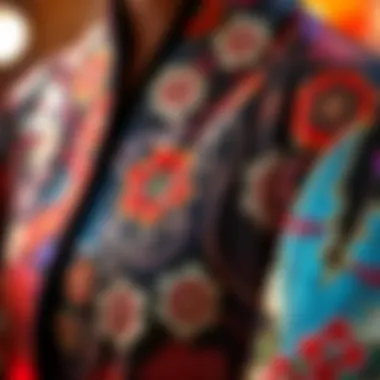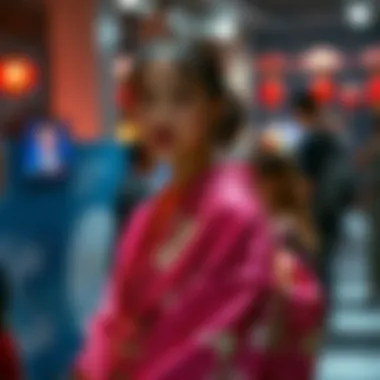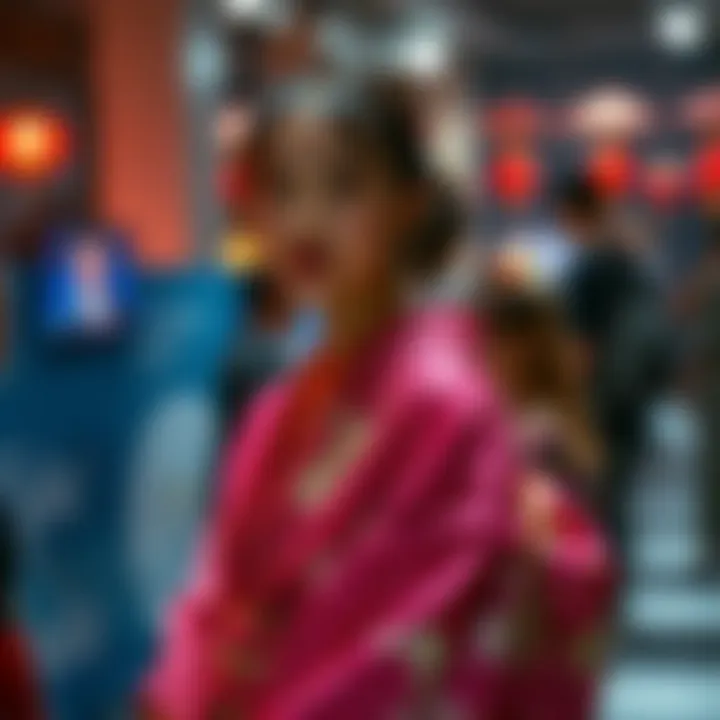The Glitter Kimono: Fashion, History, and Style Guide


Intro
The glitter kimono has captured the attention of fashion enthusiasts around the globe, transcending its traditional roots to become a modern style staple. This lavish garment, adorned with shimmering embellishments, invites us to explore a rich tapestry of culture and fashion. Whether one is attending a high-profile event or simply adding flair to everyday wear, the allure of the glitter kimono is undeniable. In this article, we will dissect its fabric composition, delve into styling strategies, and discuss care tips that will ensure your glitter kimono remains a timeless piece in your wardrobe.
Fabric Knowledge
When selecting a glitter kimono, understanding the fabric is crucial as it impacts both the garment’s look and its longevity. Different fabrics carry distinct characteristics, which influence how a kimono drapes and how it can be styled.
Types of Fabrics
- Silk: This is perhaps the most luxurious choice for a glitter kimono. Silk offers a soft feel against the skin, and its natural sheen complements glitter beautifully. However, it requires gentle handling.
- Synthetic Blends: Many modern kimonos are made from polyester or other synthetic materials, which can hold glitter more effectively. These fabrics are durable and often more affordable but might lack the same elegance as silk.
- Cotton: The everyday alternative, cotton kimonos are often lighter and more breathable, making them suitable for casual outings. Yet, they might not carry the glitter as prominently as synthetic fibers or silk.
How to Care for Different Fabrics
Caring for your glitter kimono requires attention to the fabric type to keep it in prime condition:
- Silk: Hand wash in cold water with mild detergent. Avoid wringing to preserve the glitter.
- Synthetic Blends: Machine wash on a gentle cycle inside a mesh bag. You'll want to avoid high heat when drying.
- Cotton: This fabric can typically withstand regular washing but be mindful of excessive agitation to protect the glitter elements.
"Proper care can extend the life of your glitter kimono, allowing it to sparkle through many seasons to come."
Style Tips
Getting the styling right can elevate your glitter kimono from just a statement piece to a versatile staple in your fashion repertoire.
Outfit Pairing Strategies
- Casual: Pair it with a simple tank top and tailored trousers for an effortless look that balances elegance with comfort.
- Chic Evening: Consider a fitted dress underneath the kimono, complemented by heels and statement jewelry. This combination is ideal for evening events where glamour is key.
- Layered Looks: During colder months, wear your glitter kimono over a long-sleeved turtleneck, creating a striking juxtaposition of textures and temperatures.
Seasonal Fashion Trends
Incorporating a glitter kimono into your wardrobe can be seasonally adaptable:
- Spring/Summer: Lightweight fabrics and bright colors resonate well; think floral patterns with subtle glitter accents.
- Fall/Winter: Richer hues like burgundy or emerald paired with warm layers can create an inviting look. Popular styling includes pairing with high boots and statement belts.
In the chic world of modern fashion, the glitter kimono stands a class apart - an iconic piece that marries cultural heritage with contemporary flair. It beckons wearers to embody elegance and confidence, adorned in brilliance, ready to shine in the limelight.
Foreword to the Glitter Kimono
The world of fashion is an ever-evolving tapestry, and the glitter kimono stands out as a vibrant thread woven into its intricate design. This unique garment captivates attention not just for its aesthetic appeal but also for its deeper cultural roots and significance. The glitter kimono is not merely a piece of clothing; it embodies a rich history, artistic innovation, and a dynamic intersection of tradition and modernity. By exploring its allure, we gain insight into what makes this garment a staple in both contemporary wardrobes and in the context of its cultural heritage.
In this section, we will define what precisely a glitter kimono is and delve into its historical context. Understanding these fundamental aspects will set the stage for our exploration of the glitter kimono’s role in modern fashion. The importance of this topic lies in its ability to bridge the past with the present, highlighting how traditional garments can evolve and maintain relevance in today’s style.
Defining the Glitter Kimono
A glitter kimono is typically characterized by the use of shimmering materials intertwined with classic kimono designs. Unlike traditional kimonos, which often emphasize subtlety and understated beauty, glitter kimonos bring a touch of boldness to a timeless silhouette. They often feature fabrics that are embellished with glitter or metallic threads, resulting in eye-catching pieces that reflect light in lively, unexpected ways.
- Material: These kimonos can be crafted from various fabrics, including silk, satin, or synthetic blends that are treated to hold glitter or sparkle.
- Design Elements: Patterns can range from floral motifs to geometric shapes, adding layers of complexity and artistic flair.
- Fit: Staying true to the classic silhouette, glitter kimonos maintain a loose, flowing design that allows for ease of movement.
Fashion enthusiasts often appreciate the versatility of glitter kimonos, as they can be dressed up or down — thrown over a casual outfit for some flair or worn over a sleek dress for a more formal affair. The significance of this garment extends beyond its visual appeal; it serves as a canvas for personal expression in the evolving landscape of fashion.
Historical Context of Kimonos
To fully appreciate the glitter kimono, one must first embark on a journey through the history of the kimono itself. Traditional kimonos date back to the Heian period (794-1185) in Japan, when they were worn by nobility as symbols of grace and refinement. The evolution over centuries reflects not just changes in fashion but also socio-economic conditions and cultural exchanges.
- Early Origins: Initially, kimonos were simple in design, with straight lines and a wrap-around style that enhanced comfort.
- Cultural Significance: As the kimono gained popularity, it began to serve as a representation of one's social status. The colors, patterns, and embellishments indicated rank and occasion.
- Influence of Art and Nature: Many designs were inspired by nature, showcasing the beauty of flowers, animals, and landscapes, which remains a hallmark of kimono aesthetics.
Fast forward to the 20th century, the divide between traditional and contemporary styles began to blur. The introduction of Western fashion concepts influenced how kimonos were perceived — and worn. The glitter kimono emerges as a blend of this rich history and modern fashion sensibilities, proving that tradition can adapt without losing its essence.
"The glitter kimono is not just a trend but a celebration of history, culture, and personal style— a journey through fabric that tells a story of its own."


In summary, understanding the definition and historical context of the glitter kimono sets a foundation for appreciating its significance today. This garment encapsulates a melding of traditional artistry and avant-garde fashion, continuing to inspire stylists, designers, and wearers alike.
The Cultural Significance of the Kimono
The kimono, more than just a piece of clothing, stands as a beacon of Japan’s rich cultural history. Over centuries, it has evolved from a traditional garment into a complex symbol intertwining with identity, societal norms, and personal expression. In this exploration, we uncover the layers of meaning behind the kimono’s cultural significance, specifically focusing on its symbolic aspects and modern adaptations.
Symbolism of the Kimono in Japan
At its core, the kimono represents a fusion of aesthetics and tradition. It isn’t simply worn; it carries stories and messages. For instance, the designs used in kimonos often hold specific meanings. A motif of cherry blossoms may herald renewal and the transient beauty of life, while waves might symbolize resilience. Each color choice, pattern, and fabric has its own narrative, steeped in cultural context.
Moreover, the kimono has often been linked to significant milestones, such as weddings, graduations, and other rites of passage. During such events, the choice of kimono can reflect both family heritage and personal identity. For many Japanese, wearing a kimono is a way to connect with their ancestry, embodying the values and traditions passed down through generations.
"A kimono is more than fabric; it’s a tapestry of culture, history, and identity woven into every thread."
However, the symbolism extends beyond personal narratives. The kimono is also a representation of social status. Historically, the fabrics and designs worn indicated a wearer’s position in society, a reflection of gender roles and the cultural hierarchy. The world of kimonos was a telling ground of social dynamics; while some wore luxurious silk adorned with intricate patterns, others wore simpler, more functional designs.
Modern Interpretations and Adaptations
As Japan embraced globalization, the traditional kimono began to evolve. In contemporary fashion, the glitter kimono, for instance, emerges as a vibrant reinterpretation, catering to a more global audience. It combines traditional craftsmanship with modern aesthetics, often infused with bold colors and shimmering fabrics that appeal to younger generations.
Fashion designers today are taking liberties with the kimono's silhouette and structure. Kimonos are now seen as versatile pieces—they can be draped over casual outfits or worn as statements during fashion week. This shift not only captivates the attention of fashionistas but also helps in reinvigorating interest in Japanese cultural heritage.
Furthermore, fashion events are increasingly showcasing these adaptations, celebrating the spirit of innovation while paying homage to the past. Kimono-inspired garments are often featured in international fashion shows, providing a platform for cultural exchange and a fresh perspective on traditional wear.
In cities like Tokyo, you can spot thriving boutiques specializing in modern kimono styles, attracting locals and tourists alike who are eager to experience a piece of this ancient tradition with a contemporary twist.
In summary, the cultural significance of the kimono is a rich tapestry woven from historical symbolism and current trends. It serves various roles—from a personal expression of identity and heritage to a dynamic player in the fashion industry, bridging traditional craftsmanship with modern flair. Understanding these facets of the kimono allows us to appreciate not only its aesthetic allure but its emotional depth as well.
Glitter: A Fabric and Design Analysis
Delving into the world of glitter kimonos means grappling with the fabric and design elements that elevate a typical garment into a statement piece. Glitter isn’t just a visual flair; it's a means of expressing individuality and merging tradition with modern aesthetics. Understanding how glitter as a fabric impacts the allure of kimonos is crucial for fashion enthusiasts and professionals alike. This section will explore glitter's unique characteristics and textures, as well as the implications of its use in clothing.
Understanding Glitter Fabrics
Glitter fabrics come in various forms, playing an essential role in the visual appeal of a glitter kimono. These textiles often consist of synthetic fibers like polyester or nylon, which act as a perfect canvas for shimmering applications. The addition of glitter on these fabrics can come from metallic threads or finely crushed particles adhered to the surface.
The translucent surfaces and reflective qualities of glitter combinations can create a magical interplay of light and color, depending on how they catch the eye.
- Benefits of Glitter Fabrics:
- Visual Impact: The sparkle from glitter fabrics can catch attention from afar.
- Versatility: Works well for both daytime casual styles and evening formal wear.
- Creative Expression: Allows designers to push the boundaries and explore vibrant themes.
However, designers should consider the following challenges when working with glitter fabrics:
- Weight and Structure: Some glitter fabrics may be heavier, impacting the drapability.
- Maintenance: Glitter can shed during wear or washing, necessitating special care during cleaning.
The charm of glitter fabrics lies in their varied appearances, suitable for diverse styles. If one aims to achieve a classic look, opting for subtle glitter accents might be the best route. Alternatively, a bold, oversized application can signal artistic individuality.
The Role of Texture in Fashion
When it comes to fashion, texture remains a critical consideration, especially in the context of glitter kimonos. Each texture communicates a distinct narrative and affects how the garment interacts with movement and light.
- Layering Textures: Mixing glitter fabric with other textiles can yield fascinating results. For example, pairing a glitter kimono with a soft silk blouse can create a harmonious balance, while complementary fabrics enhance the shimmering quality.
- Material Influence: The texture of the fabric beneath the glitter—be it smooth, rough, or plush—can significantly affect how the design is perceived. For instance, a finely woven fabric with glitter can appear more polished compared to a heavily textured one.
Moreover, the tactile experience adds another layer of sensuality to the garment. A glitter kimono with varied textures invites not only visual admiration but also engages the senses, urging potential wearers to touch and feel the contrasts.
"Fashion is not just about the clothes we wear, but also about how we feel when we wear them."
For additional insights on fabric choices, the history of kimonos, and more detailed exploration of cultural influences, one may refer to reputable sources like Britannica or Wikipedia.


The Evolution of the Glitter Kimono
The evolution of the glitter kimono is quite the story; it’s not merely a transition of fabric or style, but a reflection of shifting societal values, artistic expressions, and cross-cultural influences. This progression is crucial to understanding contemporary fashion, where the glitter kimono has come to represent a harmonious blend of tradition and modernity. Not only does it serve as a stunning garment, but it also embodies a statement that transcends boundaries.
From Traditional to Contemporary
The glitter kimono has its roots in the traditional attire of Japan, an iconic garment that has been worn for centuries. Initially, kimonos were made from natural fibers and came in a myriad of styles, each denoting the wearer's marital status, age, and even the occasion. The elegance of the garment lay in its simplicity and the quality of the fabric.
As time progressed, the introduction of glitter and other synthetic materials transformed these traditional garments into something audaciously contemporary. Designers began to explore how sparkle could complement the rich textiles of silk and cotton, providing a fresh twist on old classic.
Take, for instance, the way contemporary designers like Junya Watanabe and Issey Miyake have incorporated glitter elements into their collections. They toss aside traditions and, instead, focus on the concept of the kimono as a style statement—fusing it with modern silhouettes that align with today’s street fashion.
This shift raises some questions among cultural purists:
- Is it disrespectful to alter such a storied garment?
- Can a glitter kimono still hold its cultural significance?
But it seems that as long as the spirit of appreciation for the form persists, evolution may lead one to exciting new places rather than purely for commercialization. The glitter kimono, in its essence today, speaks to a diverse audience that values novelty along with tradition.
Influence of Western Fashion Trends
Western fashion influences have undeniably played a substantial role in shaping the glitter kimono as it stands now. It’s interesting to observe how Western aesthetics seep into Eastern fashion, reshaping it into a more globally palatable form.
Popular figures in Western fashion have taken notice of the allure of the kimono. Celebrities like Rihanna and Katy Perry have donned versions of the glitter kimono on various platforms, igniting a trend that resonates across oceans.
Moreover, fashion runways, especially during events like New York Fashion Week, have featured designs that merge traditional Asian styles with Western cuts. This will include vibrant colors and textures that are wholly unexpected for traditional kimonos.
The shift towards casual and relaxed clothing in the West has also influenced the acceptance of kimonos, making it less of a ceremonial wear and more of an everyday option. Think about how you might now casually throw on a glitter kimono over jeans, blurring the lines of formality.
Such influences challenge the rigidity of cultural fashion norms, pushing the glitter kimono into a realm where it can be adapted for various settings—from glamorous soirées to casual day outs.
The glitter kimono has evolved into a canvas of cultural fusion, intertwining history with an evolving modern identity, thereby creating something uniquely its own.
As we dive deeper into the world of glitter kimonos, it becomes evident that they are far more than garments; they are stories woven into fabric that, as we move forward, continue to unravel in exciting and unexpected ways.
To further explore the enduring nature of the glitter kimono and its evolution across different cultures, you could take a look at resources like Wikipedia, or the compelling discussions on Reddit. Understanding these contexts opens the door to appreciating not just the fashion but the culture and engagement it invites.
Styling the Glitter Kimono
The glitter kimono is more than just a piece of clothing; it functions as a canvas for personal expression and style. It embodies a dynamic fusion of tradition and modernity, making it a versatile choice for various occasions. Understanding how to style this unique garment is essential for those who aim to make a statement while honoring its cultural roots.
The beauty of a glitter kimono lies in its adaptability. Whether one is dressing for a casual afternoon with friends or gearing up for a formal event, this garment can fit seamlessly into the outfit. The sparkling details catch the eye, but the real skill lies in how it can be paired and styled. Each styling choice—whether it leans toward laid-back or elegant—offers insightful layers to the wearer's personality.
Casual vs. Formal Looks
When considering how to style a glitter kimono, the distinction between casual and formal looks is significant. For a casual outing, pairing the kimono with a simple white t-shirt and distressed jeans can create a laid-back ensemble that feels refreshingly chic. This style balances the boldness of the glitter with a relaxed vibe, making it appropriate for brunch with pals or a stroll through a weekend market.
On the other hand, for a more formal occasion, the approach changes. A figure-hugging bodycon dress underneath the kimono, paired with heels and subtle jewelry, can elevate the overall appearance to one of graceful sophistication. The glitter adds an air of luxury, perfect for evening events or cocktail parties. To further enhance the look, one might opt for a sleek updo—this lets the kimono's shimmering patterns and textures truly shine.
Pairing with Other Garments
Incorporating other garments when styling a glitter kimono opens up a world of possibilities. Think about layering it over a fitted turtleneck for colder months, or combining it with a playful maxi skirt for a summer festival. The versatility allows one to play with colors and fabrics, creating contrasts or harmonious blends.
A denim jacket can introduce a street-style edge, completely transforming the glitter kimono's vibe. Alternatively, for a classic and timeless approach, one might choose to wear it with tailored trousers or a pencil skirt—fitting options that harmonize with the kimono's lengthy silhouette.
Crucially, the fabric choices of the additional garments can either complement or contrast the glitter. Silks and satins work seamlessly, while cotton and linen can introduce a grounded feel to visually offset the glitz.
Accessorizing Your Look
The right accessories can elevate the glitter kimono look exponentially. Whether you reach for statement earrings, layered necklaces, or an extravagant clutch, thoughtful choices will enhance the overall outfit.


Bold earrings are particularly effective when wearing a glitter kimono, as they attract attention while framing the face. Opt for pieces that whisper elegance rather than shout for glory—this approach keeps focus on the kimono itself without overwhelming it. For necklaces, consider a delicate chain with a tiny pendant or choker; they provide interest without competing against the kimono’s sparkle.
Moreover, the footwear chosen can dramatically change the entire aesthetic. Ankle boots give off a trendy vibe, whereas strappy sandals might add a touch of sophistication suitable for more upscale venues. A well-placed belt can even cinch the waist, striking an appealing balance between the flowing fabric and structure.
In styling the glitter kimono, it's essential to keep an eye on cohesion. Opting for colors that echo the glittery tones of the kimono will create a polished look that feels both intentional and stylish.
Ultimately, styling the glitter kimono is about more than just aesthetics; it's about crafting an outfit that resonates with one's identity and confidence. Flourishing in its glow, this garment brings both flair and consciousness to personal fashion choices.
Care and Maintenance of Glitter Kimonos
Caring for glitter kimonos is not just an added chore; it's an essential aspect of preserving the splendor and charm of these unique garments. The luminosity of glitter combined with delicate fabrics demands special attention. Proper care ensures that the garment remains in top condition, allowing the wearer to showcase its beauty for many occasions to come. By understanding the right cleaning techniques and storage practices, you can prolong the life of your glitter kimono while enhancing its allure.
Cleaning Guidelines
Cleaning a glitter kimono is a careful process. Here, various factors come into play, including fabric type, glitter application, and any embellishments present.
- Hand-Washing: For most glitter kimonos, a gentle hand wash is advisable. Fill a basin with lukewarm water and add a mild detergent, specifically one that’s free of harsh chemicals. Gently submerge the garment, swirling it gently, but avoid any vigorous scrubbing, which can damage the fibers or glitter.
- Spot Cleaning: If stains or spills occur, act quickly. Dab the soiled area with a cloth soaked in a diluted solution of water and mild detergent. Pat lightly; do not rub aggressively.
- Air Dry: Avoid the dryer like the plague. Lay the kimono flat on a clean towel, reshaping it as necessary to maintain its original form. Leave it to air dry away from direct sunlight, which can fade colors and dull the glitter's shine.
"A little care goes a long way in keeping your glitter kimono dazzling and eye-catching."
Storage Practices
Storing a glitter kimono properly can be just as important as how you clean it. Improper storage can lead to creases, fading, or cracking of the glitter, which ruins its visual appeal.
- Use a Garment Bag: A breathable garment bag is your best friend. This not only protects the kimono from dust but also allows air circulation, minimizing moisture buildup. Avoid plastic covers, as they can trap humidity and promote mildew.
- Hang with Care: When hanging your kimono, utilize wide padded hangers to help maintain its shape, reducing stress on the fabric. Avoid using wire hangers as they can cause unwanted marks or creases.
- Keep Away from Light: Store your glitter kimono in a dark, cool place, ideally in a closet to shield it from light, which can lead to fading.
By investing time in the care and maintenance of your glitter kimono, you are ensuring that your piece not only retains its vibrant shine but also serves as an enduring symbol of elegance and style in your wardrobe.
Glitter Kimonos in the Fashion Industry
The glitter kimono has carved a niche in the modern fashion landscape, bridging traditional craftsmanship with contemporary flair. Its emergence as a staple in both high fashion and streetwear signifies profound shifts in how kimonos are perceived and utilized in today’s apparel market. As global fashion increasingly embraces cultural diversity, glitter kimonos stand out not just as garments, but as powerful statements reflecting artistic expression and identity.
Importance in Fashion: The glitter kimono resonates with an audience that values individuality and creativity. It acts as a canvas where designers can showcase their interpretations of traditional motifs through contemporary materials. The blend of sparkling embellishments with timeless elements of kimonos intrigues both fashion enthusiasts and casual wearers.
Runway Trends and Features
The influence of glitter kimonos on the runway cannot be overlooked. High-profile fashion shows often feature them prominently, signaling trends that ripple throughout the industry. Designers often experiment with various colors, fabric types, and styles, creating a wide array of options for consumers.
- Vibrant Patterns: Fashion weeks have showcased glitter kimonos adorned with bold patterns, merging Western design aesthetics with traditional Japanese artistry.
- Layering Styles: Pairing them with modern outfits, like high-waisted jeans or sleek dresses, highlights their versatility, allowing them to transcend cultural barriers.
- Sustainable Practices: Many designers are also focusing on sustainability by using eco-friendly glitter, promoting a conscious approach in fashion.
"Glitter kimonos are a vibrant expression of culture and identity, making them a trend that goes beyond mere fabric."
Celebrity Endorsements and Influence
Celebrities play a pivotal role in propelling trends into the mainstream. When they step out in a glitter kimono, the world takes notice.
- Influencing Fashion Choices: Celebrities like Zendaya and Rihanna have been spotted wearing these kimonos, sparking interest and widespread adoption among fans and followers.
- Red Carpet Appearances: The allure of glitter kimonos on red carpets illustrates their capacity to make bold fashion statements, often becoming the talk of the event.
- Social Media Impact: Platforms like Instagram amplify this influence, as fashion influencers showcase their unique styling of glitter kimonos, encouraging others to incorporate them into their wardrobes.
In summary, glitter kimonos serve as a bridge between tradition and modernity in the fashion industry. As trends on the runway evolve and celebrity endorsements continue to inspire, the glitter kimono's appeal is likely to grow, cementing its role as a cultural and fashion phenomenon.
End: Embracing the Glitter Kimono
The glitter kimono stands as a fascinating interaction between tradition and modernity, a celebration of culture woven into the fabric of contemporary fashion. As we reflect on the journey of this garment, its importance emerges not only through its aesthetic appeal but also as a canvas for personal expression. This final section encapsulates the multifaceted reasons why embracing the glitter kimono is beneficial, especially for fashion enthusiasts, stylists, and retailers.
Personal Expression Through Fashion Choices
In a world where fashion often serves as an extension of personal identity, the glitter kimono provides a unique opportunity for individuals to express themselves. There’s something about its shimmering fabric that draws attention and fosters creativity. When you wear a glitter kimono, you’re not just donning a piece of clothing; you're making a statement. It acts as a palette where everyone can splash their personality, culture, and mood.
This garment allows for versatility in styling. For instance, pairing a vibrant glitter kimono with casual denim can shift an everyday look into a show-stopping ensemble. The options are endless—whether you dress it up with elegant accessories or keep it laid back, the glitter kimono adapts to your choices. Additionally, the cultural significance tied to kimonos adds deeper meaning to how one can interpret their style, weaving stories of heritage and modernity into each outfit.
The Future of the Glitter Kimono in Fashion
Looking forward, the glitter kimono appears poised for continued relevance in the fashion landscape. With the merging of technology and textile design, innovators create glitter fabrics that both surprise and delight. Imagine eco-friendly options or even interactive materials that change color—these advancements could take the allure of the glitter kimono to unprecedented heights.
Moreover, as global influences intertwine, the kimono is likely to inspire myriad designs across different cultures, leading to collaborations that break the norm. We can expect to see more diversity in how kimonos are crafted, encouraging even more dynamic expressions in fashion. Combined with ongoing interest from influencers and fashion icons, the glitter kimono's evolution may well spark a renewed appreciation, turning it from a niche trend into a staple for many wardrobes.
"The brilliance of the glitter kimono is its ability to resonate with cultures while evolving in contemporary settings. This duality helps keep it alive and relevant in the ever-changing world of fashion."















